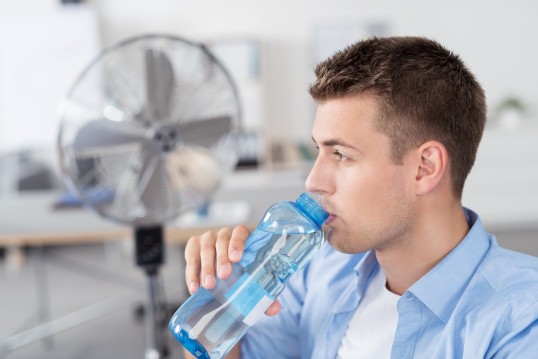- Artificial Intelligence (AI)
- Occupational exposure limit values
- Climate Change and Occupational Safety
- List of CMR substances
- Electromagnetic fields
- Ergonomics
- Industrial Security
- Collaborative robots
- Noise
- Nanoparticles at the workplace
- Optical Radiation
- REACH
- Reference materials
- Proficiency testing
- Vibration
- Virtual reality
- Work 4.0
Heat

Source: contrastwerkstatt - stock.adobe.com
Background
For the past ten years, the ground-level air temperature in Germany has been around 2 °C higher than in the decades of the earliest records (1881-1910). With the exception of 1994, the hottest ten years in Germany have all occurred since the turn of the millennium. The number of hot days, i.e. with temperatures above 30 °C, is increasing as a result of climate change, and heatwaves of longer duration are occurring, particularly in summer. This can lead to excessive heat stress during outdoor work. Climate change is also causing an increase in temperatures indoors, e.g. in office buildings, schools and factories, associated with increasing heat stress for workers at indoor workplaces, and also for children and young people in daycare facilities and schools. If heavy physical work or work in insulating protective clothing is performed at high ambient temperatures, the heat stress increases further still.
When work is performed at high ambient temperatures, the human body may be unable to maintain the required thermoregulation. Hyperthermia (overheating of the body) then occurs, presenting risks to health.
Effective measures must be taken to reduce the exposure of employees, children and young people to high summer temperatures in indoor environments. Many of these measures are already part of various statutory regulations in Germany, such as the Workplace Ordinance (ArbStättV), which is supported, for example, by the ASR 3.5 technical rules for workplaces governing room temperature. Measures for protection against excessive temperatures at the workplace are also set out in publications of the German Social Accident Insurance (DGUV) and in standards.
The Sub-committee Indoor climate in the DGUV’s Expert committee Administration provides a range of information that also addresses climate change. The FBVW-505 Fachbereich AKTUELL information brochure on climate change and hot work environments, for example, explains the different concepts of heat in the context of climate change and occupational safety and health. This is important, one reason being that the regulations applicable in Germany to hot work environments in the context of occupational safety and health differ, for example, between work in steelworks and in summer heat. The latter is often associated with a hot work environment in relation to climate change.
Work of the KKA at the IFA
The IFA advises on measures for protection against climatic stress, both in the thermal comfort zone and in the hot and cold zones. This also includes advice on measures for dealing with increased thermal stress caused by higher temperatures in the summer months. The IFA evaluates ventilation systems and advises on scope for optimization. It provides support for assessing work intensity and physical workloads under conditions of heat and for selecting suitable preventive measures (e.g. cooling vests).
Contact

Competence Centre for Climate Change and Occupational Safety and Health at the IFA
Email: kka@dguv.de
Contact:
Dr Simone Peters
Tel.: +49 30 13001-3320
Further Information

High Workplace Room Temperatures (Institute for Occupational Safety and Health, BAuA)
Survey of workers on: The effects of climate change in relation to safety and health at the workplace (Institute for Work and Health, IAG)